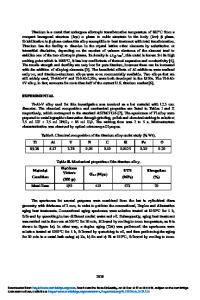Effect of Alloy Composition & Helium ion-irradiation on the Mechanical Properties of Tungsten, Tungsten-Tantalum &am
- PDF / 316,370 Bytes
- 6 Pages / 432 x 648 pts Page_size
- 18 Downloads / 318 Views
Effect of Alloy Composition & Helium ion-irradiation on the Mechanical Properties of Tungsten, Tungsten-Tantalum & Tungsten-Rhenium for Fusion Power Applications
Christian E. Beck1, Steve G. Roberts1, Philip D. Edmondson1 and David E. J. Armstrong1 Department of Materials, University of Oxford, Parks Road, Oxford, OX1 3PH, UK
1
ABSTRACT Model alloys have been made of pure W and 1% & 5% W-Ta and W-Re. Indentation hardness and modulus data were obtained by nanoindentation to assess the effect of composition on mechanical properties. Results showed that both the Ta and Re compositions hardened with increasing alloy content, greater in the W-5%Ta composition which showed an increase of 1.03GPa (17%), compared to a 0.43GPa (7%) increase in W-5%Re. The samples also showed very small increases in modulus of ~ 25GPa (6%) in both W-5%Re and W-5%Ta. The samples were implanted with 3000appm concentration of helium. All samples show a substantial increase in hardness of up to 107% in the case of pure W. An appreciable difference in modulus is also seen in all samples. Initial TEM work has shown no visible He bubbles, suggesting that the mechanical properties changes are due to He-vacancy cluster formation below the resolvable limit. INTRODUCTION Tungsten-based alloys are being considered as likely candidate materials for plasma-facing components in a nuclear fusion reactor. Structural components in the divertor and particularly the divertor plate will potentially be exposed to maximum operating temperatures in excess of 1000°C whilst being bombarded with 14.1MeV neutrons producing displacement damage of up to 120dpa over the divertor lifetime [1]. In addition to the cascade damage produced, helium retention in the first wall material from direct injection of plasma ions and neutron-induced transmutation events also has the potential to produce microstructural changes and in turn significant mechanical changes, although these are as yet not well characterised [2-4]. Tungstenbased alloys represent the greatest hope of being able to eventually fulfil the material requirements due to their high melting point (3695K), good resistance to sputtering and void swelling, relatively low tritium retention rates and good thermal resistance and conductivity properties, which remain stable under irradiation [5-6]. Tungsten alloys however have some drawbacks: high ductile to brittle transition temperature (DBTT), susceptibility to radiation embrittlement and processing issues due to their high melting temperature will have to be overcome [2,7-8]. The effect of alloying additions on the properties of tungsten is of interest for two reasons: firstly, deliberate alloying has the potential to improve material properties and secondly, to assess the effects of ‘transmutation alloying’. Modelling has shown that over a 5 year service period for divertor conditions in a fusion power plant such as DEMO, over 5% of the tungsten would be transmuted, with rhenium and tantalum being two of the most significant transmutants [9]. It is therefore important
Data Loading...











